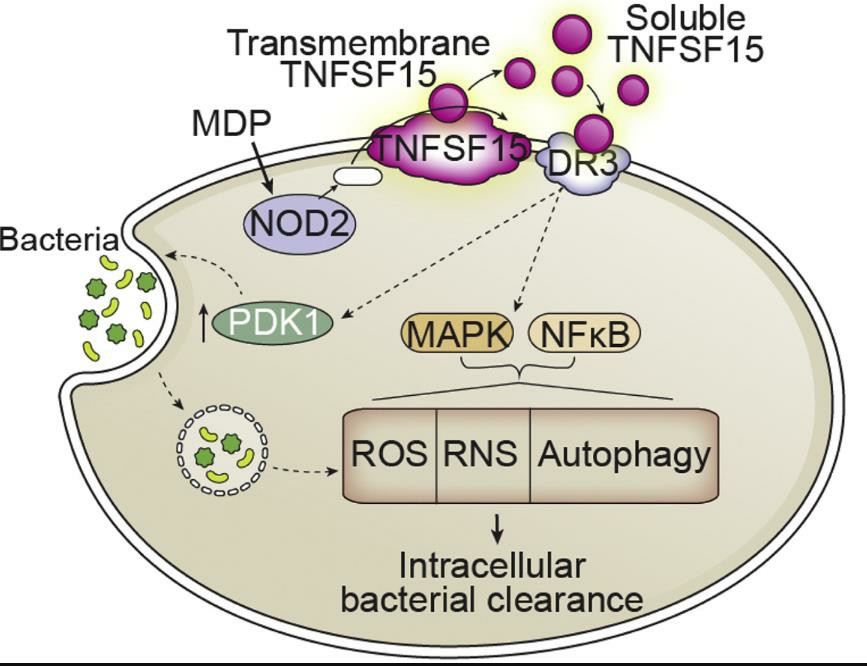What is TNFSF15 Protein?
Tumor Necrosis Factor Superfamily Member 15 (TNFSF15), also known as Vascular Endothelial Growth Inhibitor (VEGI), represents an integral part of the large TNF superfamily which comprises cell surface proteins with crucial roles in immune response, apoptosis, and inflammation. The TNFSF15 gene, coding for the TNFSF15 protein, was first discovered in 1997.
Gene Locus and Structural Details
Located on the long arm of chromosome 9 at location 9q32, the TNFSF15 gene stretches over 18,850 bases. The mature TNFSF15 protein has 192 amino acids, subdivided into three distinctive domains: a TNF homology domain for receptor binding, a coiled-coil stalk region for trimerization, and an intracellular N-terminal region. These structural domains collectively contribute to the unique functionality of TNFSF15.
Function of TNFSF15 Protein
Key studies unravel that TNFSF15 protein is a vital immune modulator with strong anti-inflammatory properties. It exerts control on the immune system by inhibiting the growth of endothelial cells, inducing apoptosis, negatively regulating angiogenesis, and differentiation of T-helper 17 cells, vital immune cell subsets. Moreover, the protein maintains the gut mucosal barrier's integrity and contributes to a healthy gut flora by modulating the intestinal immune response.
TNFSF15 Protein Related Signal Pathway
Fundamental to TNFSF15 protein functionality is its signaling pathway. It interacts with death domain receptor-3 (DR3) or TNF receptor superfamily member 25 (TNFRSF25) present on the immune cells, to form the TNFSF15-DR3 signaling pathway. Once bound, intracellular signals are triggered leading to the activation of Nuclear Factor Kappa-light-chain-enhancer of activated B cells (NF-κB) and mitogen-activated protein kinases (MAPK). Activated NF-κB translocate to the nucleus, controlling the transcription of DNA, cytokine production, and cell survival. Simultaneously, the MAPK pathway controls cell functions like proliferation, gene expression, differentiation, mitosis, cell survival, and apoptosis.

Fig1. TNFSF15 Promotes Antimicrobial Pathways
TNFSF15 Protein Related Diseases
Several emerging studies highlight TNFSF15's link to a spectrum of inflammatory and auto-immune conditions. Elevated TNFSF15 levels have been detected in Crohn's disease, ulcerative colitis, rheumatoid arthritis, systemic lupus erythematosus, psoriasis, and inflammatory bowel disease, indicating its fundamental role in the pathogenesis of these conditions. Surprisingly, protective genetic variations in TNFSF15 have been noted in certain populations, revealing complex disease-mediated regulation of the protein.
TNFSF15 Protein's Applications in Biomedical Research
The significant role of the TNFSF15 protein in inflammation and immune response makes it a promising target for biomedical research. Anti-TNFSF15 therapies using antibodies may prove beneficial in treating inflammatory diseases. In cancer biology too, TNFSF15's anti-angiogenic properties provide an avenue for developing novel therapeutics. As a guardian of gut mucosal barrier, TNFSF15 bears a potential role in the modulation of gut microbiota, paving the way for gut microbiota-related therapeutic strategies.
In conclusion, TNFSF15 protein has unveiled an exciting world of molecular biology associated with inflammation and immune response. Its distinctive structure and complex signaling pathways command a pivotal role in numerous pathological conditions. Relentless ongoing research will only uncover more about this protein's enigmatic nature paving the way for its effective utilisation in modern medicine. The potential is vast; whether utilized as a pathogenic marker, a therapeutic target, or a tool to unravel cellular mysteries, TNFSF15 embodies a powerful resource in biomedicine's future.
Our Featured Products
| Cat.No. | Product Name | Species | Source (Host) | Tag |
|---|---|---|---|---|
| TNFSF15-6203R | Recombinant Rat TNFSF15 Protein | Rat | Mammalian Cell | His |
| Tnfsf15-8724R | Recombinant Rat Tnfsf15, Fc tagged | Rat | Human Cell | Fc |
| Tnfsf15-7935R | Recombinant Rat Tnfsf15 protein, His & T7-tagged | Rat | E.coli | His/T7 |
| TNFSF15-5860R | Recombinant Rat TNFSF15 Protein, His (Fc)-Avi-tagged | Rat | HEK293 | His (Fc)-Avi |
| Tnfsf15-402M | Active Recombinant Mouse Tnfsf15, Met-tagged | Mouse | E.coli | Met |
| TNFSF15-0741M | Active Recombinant Mouse TNFSF15 protein, His-tagged | Mouse | HEK293 | His |
Reference
- Sun, R., Hedl, M., & Abraham, C. (2020). TNFSF15 Promotes Antimicrobial Pathways in Human Macrophages and These Are Modulated by TNFSF15 Disease-Risk Variants. Cellular and Molecular Gastroenterology and Hepatology, 11(1), 249-272. https://doi.org/10.1016/j.jcmgh.2020.08.003

